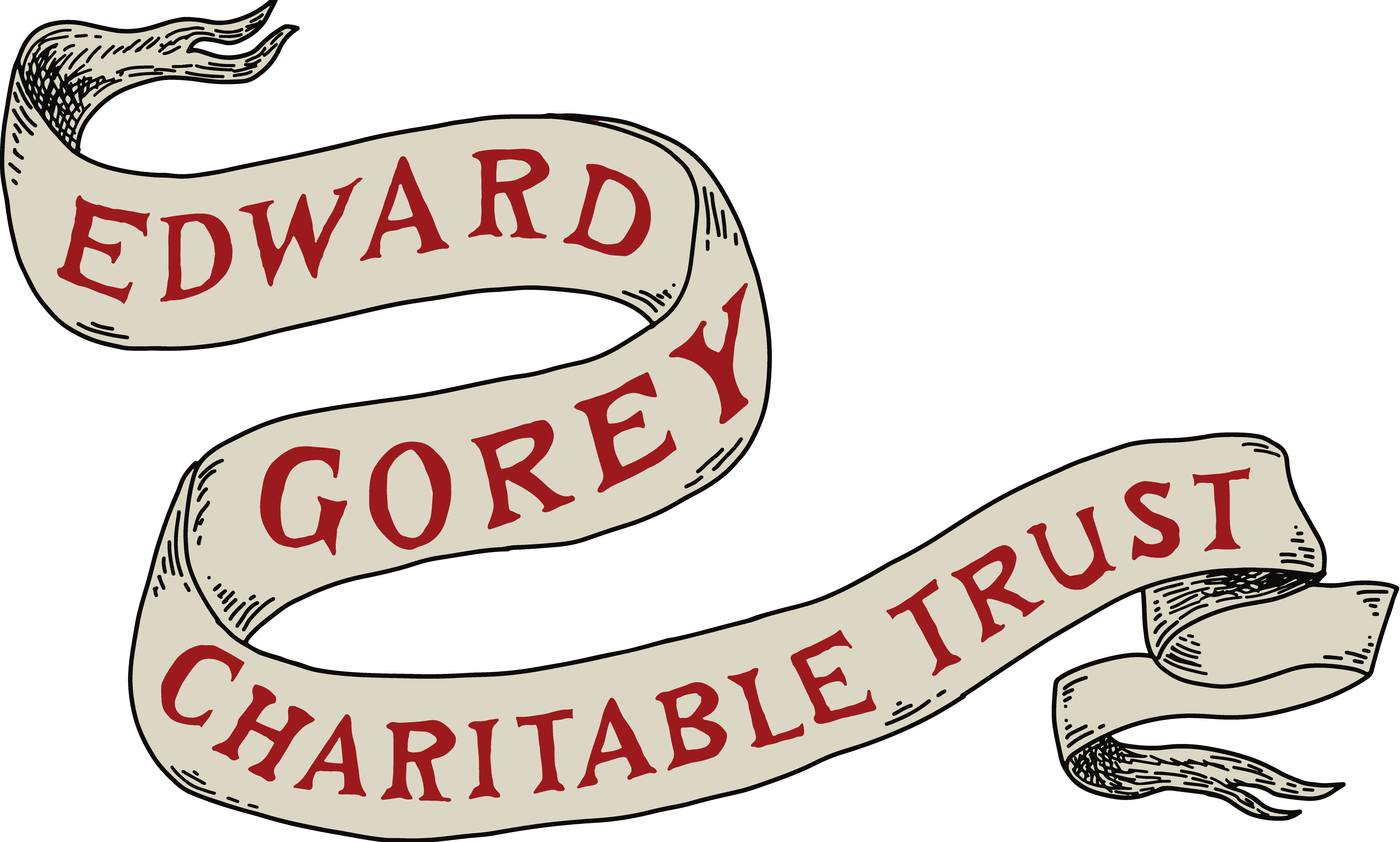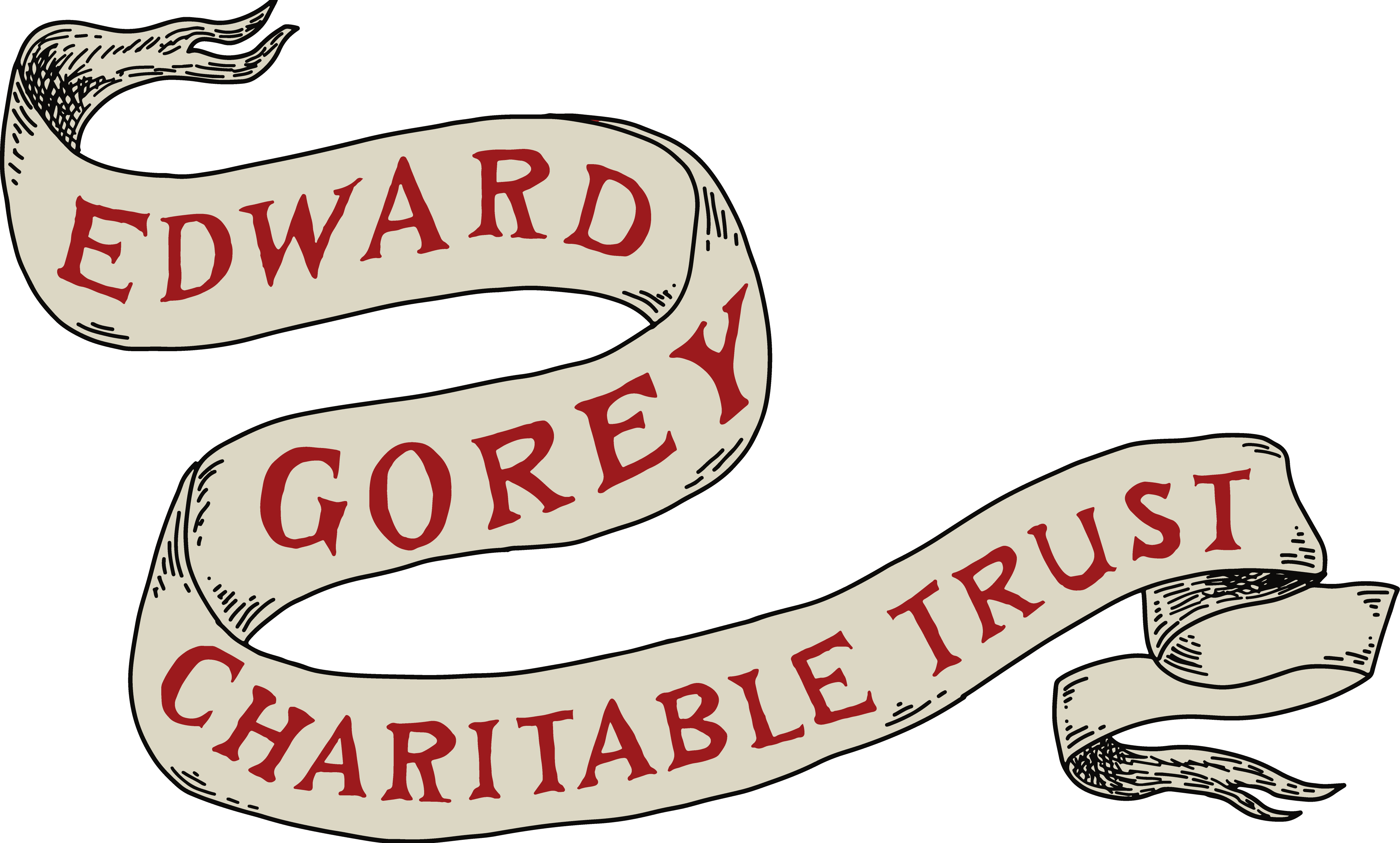The Green Beads (1978)
The Edward Gorey Charitable Trust has partnered with writer (Gorey Secrets, Great Comic Cats) and Gorey collector Malcolm Whyte to publish articles and chapters from his most recent work, Edward Gorey Tales Explored, on our Gorey Voices blog. Over the next few months, the Trust will showcase approximately 15 articles written by Mr. Whyte, each focusing on a different book by Edward Gorey. This collaboration offers a wonderful opportunity to delve deeper into Gorey’s works through the perspective of one of his most avid followers.

First appearing in Gorey’s Fantod Press’s catalog in a paperback edition of only 400 copies The Green Beads is dedicated “to the Neumeyers.” Learning about the dedicatees and their connection to the book was a gripping and complicated search composed of clues from the book itself, Peter Neumeyer’s story, and Gorey’s inimitable extrapolation. While the published story is slightly unhinged —not unlike an old-fashioned fairytale with touches of Gorey’s dry whimsey— its source of inspiration, once uncovered, imbues it with a most profound meaning.
Gorey’s Story
The Green Beads is set during bleak mid-winter in a small European village. A gloomy pall casts an aura of perpetual twilight. Half-melted mounds of snow are everywhere. The home of protagonist, Tancred, is sparely furnished. Lath shows through areas where the wall cover has worn away. Nevertheless, it is a place of love and family—a cheery oasis from the dour outside.
The book opens on dutiful Little Tancred at the door of their home where his mother sends him “to buy three pennies’ worth of tapioca with which to make their evening meal. Hardly has the little boy gone half-way when he meets “a disturbed person whose sex was unclear “ and who mistakes Tancred for his infant sister, whom, he explains, “died last autumn from a disorder of the spine brought on by a lack of nourishing food.” Upset by this report, the Disturbed Person wails “how it knocks my heart,” and rends the string of green beads upon which she had been chewing, sending them flying into the grimy drifts of snow. Suddenly she announces, “I am the Baroness von Rettig, your grandmother” and with that the boy walks her to his home.
When Little Tancred tells his mother who this person is, his mother says “we thought you were lost when the Moon of Valparaiso went down in the bay three years ago and Wilhelm, your only child, died of pneumonia contracted after helping to man the breeches-buoy all night in vain. But if you are not lying on the bottom of the sea,” she added, “can it be possible that your emerald necklace is not there after all either?” Tancred explained that when they met the Baroness “was chewing some green beads, but they broke and rolled away.”
The book ends with the reunited family—lantern lit against the dark, cold night—rushing into the street to hunt for the lost emeralds. They only found, however, something “that proved to be a glass marble belonging to a more fortunate little boy named Hugo who lived further up the block.”
Peter’s Story
While designing three books that Peter Neumeyer had written: Donald and the …, Donald has a Difficulty, and Why we have Day and Night, Gorey (known by his friends as “Ted”) became close friends with Peter and his wife Helen. During these highly creative months the men discussed their lives, shared philosophical readings, exchanged books, and animatedly planned each next project together by phone, voluminous correspondence, and occasional in-person meetings. Peter has documented this unique period in his absorbing Floating Worlds, the Letters of Edward Gorey & Peter F. Neumeyer (2011).
In one of his letters to Peter reprinted in Floating Worlds, Gorey playfully verifies his inspiration for The Green Beads: “The Green Beads … is very much derived from you, a fact for which I can find no reason whatever for you to find complimentary.” *
Taking his cue from Peter’s Germanic origins, Gorey structured The Green Beads similar to tales by the Grimm Brothers. Peter notes, “Little Tancred” is the sort of pseudonym that well might be attributed to him by Gorey as the name is, at its most distant roots, Germanic. Regarding tapioca, it’s sort of an inside joke: Ted knew very well that tapioca was my was least favorite dessert.
Throughout The Green Beads Gorey slyly contrasts Tancred’s good mother to what Peter had shared of his own mother. “My parents were not kind,” sighs Peter. “Both were woefully ignorant of the needs and welfare of a child. My mother was neurotic and abusive, alienating almost everyone she knew. My father was preoccupied and distant. Ted knew of all this because we rambled on fairly uninhibitedly about very personal things when we were together.”
“In 1936, my parents fled Munich for the United States,” Peter continues “.leaving three vulnerable Jews alone in Nazi Germany — me and my grandparents, Karl and Anna. This beloved woman sheltered me, played hide-and seek with me in Munich’s beautiful Englisher Garten, and would bring me to America a year later. She stayed about a week before returning to Karl who, as a Professor of International Law, was deprived of his job — as were all Jews, in 1933 Germany— and was not permitted to leave the country. Together they committed suicide one night in June, 1941, the night before they would have been shipped off to a prison camp.”
Having to start a new life in a new land at age eight was difficult. Doing so without the loving Anna made Peter’s induring his parents’ indifference even more painful. They ignored his company and left him pretty much by himself when they went traveling —and, at the end, Peter’s mother formally, legally disinherited him.
Drama in The Green Beads accelerates when the Disturbed Person (representing Peter’s highly neurotic mother), suddenly stops waving madly about and mistakes Little Tancred for Clorinda. The reference to her passing “ last autumn from a disorder of the spine“ is another personal reference. Gorey was well aware of the seemingly endless spinal troubles and operations Peter had been having, as long as they knew each other.
In some folk tales the monster is ultimately unmasked as an enchanted Prince. Just so, after the green beads break loose, we turn the page and — surprise! the Disturbed Person announces, “I am the Baroness von Retting … your grandmother!” It is not only a marvelous classic revelation scene, but also allows for some Gorey wordplay on the Baroness’s name. Peter points out “Rettung is the German noun for Rescue. Ergo ‘Baroness of the Rescue’, and we have another reference to grandmother, Anna, who rescued me when she delivered me safely to Oakland California, in 1937.”
The front cover drawing of The Green Beads masterfully depicts the Moon of Valparaiso’s sinking and the death of Wilhelm as recalled by Tancred’s mother. The art also symbolizes Peter’s fraught sea journey and stormy, migrant childhood, as under a dark, scowling sky, a lone man (Wilhelm) stands precariously barefooted on slippery boulders, trying to brace himself against cutting winds and lashing waves that will sink the Moon of Valparaiso, all the while holding on to a single line for dear life.
One last anguishing storybook/real-life overlap occurred to Peter. “Grandmother’s loss of a treasure from her life—the green beads — corresponds emotionally with her real world in which she lost her life, itself.”
Peter sums up, “I realize this is not the real life cast of characters, but the Teutonic threads, the disturbed person, the grandmother, the loss, the accent, the waif-like little boy— I think, put all those things together, and you have Gorey mixing up a little story-gruel for the grown up version of the little kid who had been mistreated or neglected by the cruel Disturbed Person, and rescued by the Baroness. If The Green Beads doesn’t all come together that’s just fine, it’s a story, or as Wordsworth expressed it, ‘emotion recollected in tranquility.’”
Ends Well
Despite some real tragedy in The Green Bead, all is not lost. An emerald necklace, a symbol of misplaced value, is broken and lost, while a cherished grandmother is restored to her joyful family.
In spite of Peter’s rough beginnings coming to the United States, he succeeded as a scholar, author, and critic, having taught at Harvard, SUNY (New York), University of Wales, and San Diego State University, where in 1978 he founded one of the first institutional studies of Children’s Literature in North America. In addition to the four books illustrated by Gorey, Neumeyer’s prolific career included translating a half-dozen books, publishing hundreds of reviews, articles and poems as well as his classic The Annotated Charlotte’s Web. He maintains an active life with daily walks, writing poetry, and visiting family and many creative friends from around the world.
By Malcolm Whyte
[i] Peter F. Neumeyer Oral History, San Diego State University, April, 2010. Author interview with Neumeyer, spring 2022.
[ii] Gorey has stated that he rarely has any inter-action with authors whose books he illustrated. The assignment is strictly through the book’s publisher. (Goreyana, The Bellairs Archive, Part 3 -Edward Gorey. May 2, 2011)




